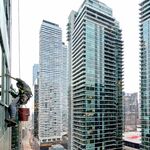Cobra
Senior Member
I agree with changing the thread name. Like him, hate him or despise him, the man is dead. He didnt dismantle the network despite his dislike of it. Time to move on.
Well, taken at face value (which is about as inaccurate as it gets, but I will humour it for soundbite), it is "responsible" for 1/3 of the accidents. How about the other 2/3s? Scrap the car, save the cyclist?
It would do well from someone employed by an org whose mantra is "scrap the creditor, save the paper".
AoD
Its not just drivers, its pedestrians.
I've seen on several occasions pedestrians get insanely close to the streetcars as they pass.
There should be a simple and light fence separating the streetcar system from the pedestrian walkway next to it.
That entire articles sounds sarcastic to me.
And isn't there a study that say a good portion of cyclist accidents are at the fault of cyclists?
How about licensing cycling in Toronto? If they're going to share the road with licensed car drivers, they should learn the traffic rules too.
When was the last time you saw a bike properly stop at a stop sign, or not dangerously pass right turning cars on the right at intersections.
As for the passing cars on the right at intersections, that's actually what the law requires cyclists to do, since they are supposed to remain within a meter of the curb unless there is an obstruction. The cyclist has right of way in that circumstance, just like a pedestrian crossing would.
I'm pretty sure the intent of the 'within 1 m of the curb' rule is not for cyclists to be between the curb and right-turning cars. The right-of-way that a cyclist has over a right-turning car at an intersection is subject to the order in which both arrive at the intersection. It doesn't mean go in front of the car that's turning, for one thing.
There are responsibilities placed both on drivers when making right turns and on cyclists when passing a vehicle to the right. Requirements for motorists or cyclists to yield depend on the particular circumstances encountered.
The rules-of-the-road state that when a motor vehicle driver plans to turn right, they must signal and only make the movement when safe to do so, using due care and attention to avoid a collision. For the turn to be safe, a driver should check for other motor vehicles as well as cyclists and pedestrians who could potentially enter the path of their turn.
The cyclist should also follow the law. Passing on the right is allowed where there is unobstructed pavement for two vehicles to pass. The pass must only be made when safe to do so. Therefore, a cyclist passing a vehicle ahead that is clearly signaling a right turn ? which might block their path at any time ? would not be making a ?pass in safety.?
Municipal bylaws govern bike lane use. Most municipalities follow the Transportation Association of Canada’s guidelines for bicycle lane design. At an intersection, the solid line of the bicycle lane becomes a dashed line to warn motorists they are crossing into the bicycle lane. The dashed line also serves to alert cyclists that there may be turning vehicles crossing their path.
Au contraire. The streetcar service on my street has changed little since then. Not everyone only rides the 510 ...Really?
That was 88 years ago.
I'm pretty sure that means little to nothing to people schleping on a streetcar today.
Agreed! It was a nightmare era and is over, until the next time.Au contraire. The thread title - thread really should be closed. It was a 2010 election thread. There's other threads.
That's true for basic bike lanes when they are dashed at intersections. Cycle tracks (Richmond, Adelaide, Sherbourne, etc), the driver has to yield to cyclists approaching from the rear.
It's also true for off-street MUP crossings which are signalized and striped, which are treated similar to the pedestrian crossing. Cars must give the ROW.
I agreed with the locking of the thread since Ford is no longer with use and there are a number of other threads where things can be posted related to streetcars. There are other threads for other things as well that are being posted here.Au contraire. The streetcar service on my street has changed little since then. Not everyone only rides the 510 ...
As for the thread title - thread really should be closed. It was a 2010 election thread. There's other threads.
The thread served its course. As much as I don't like him, he is dead and streetcars still run in Toronto, right down to the TTC opening a new streetcar line shortly after his death.I agreed with the locking of the thread since Ford is no longer with use and there are a number of other threads where things can be posted related to streetcars. There are other threads for other things as well that are being posted here.
What is a MUP crossing? Please explain.





